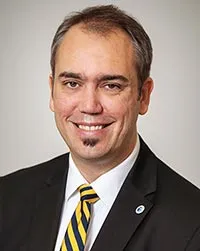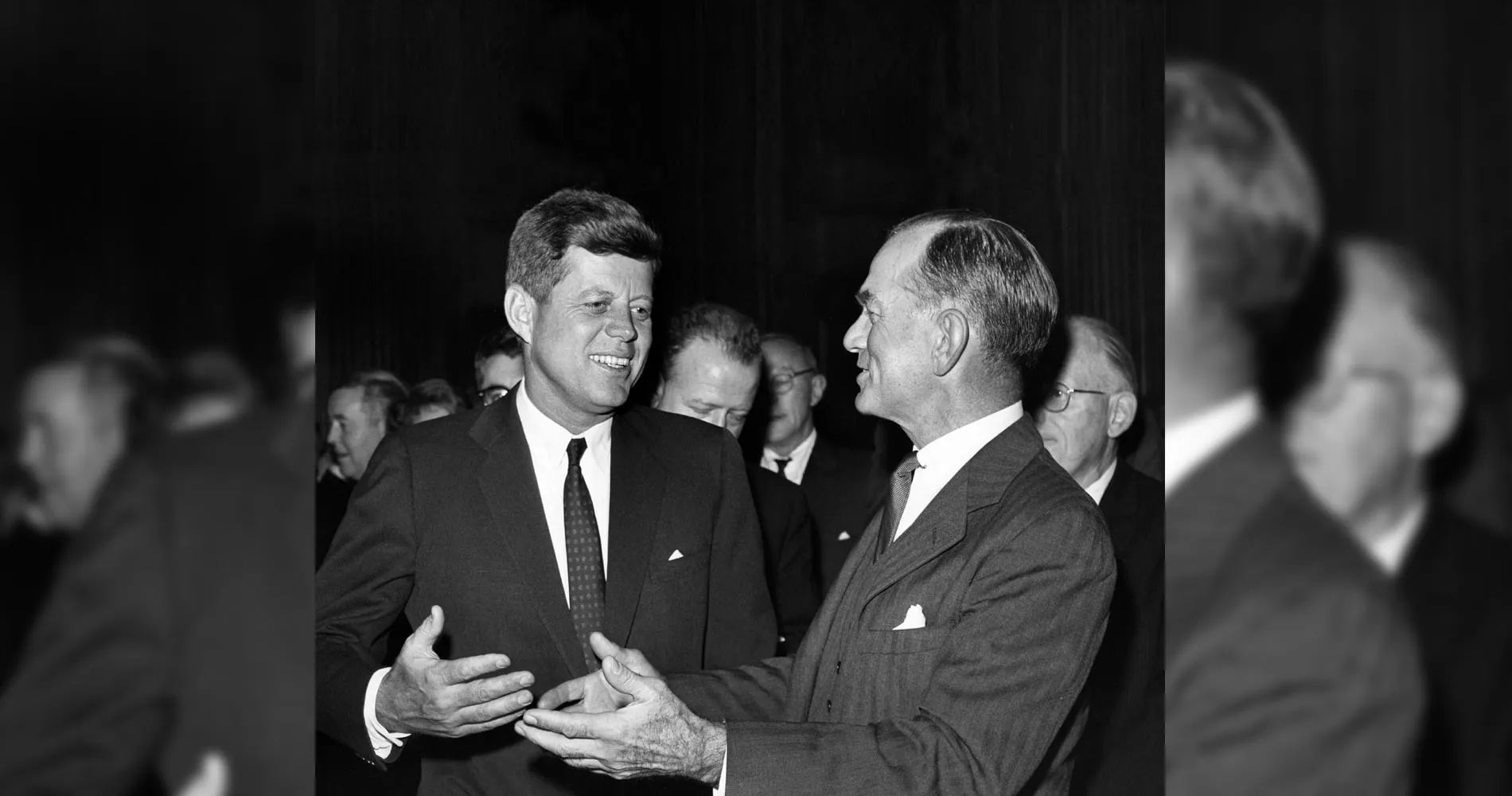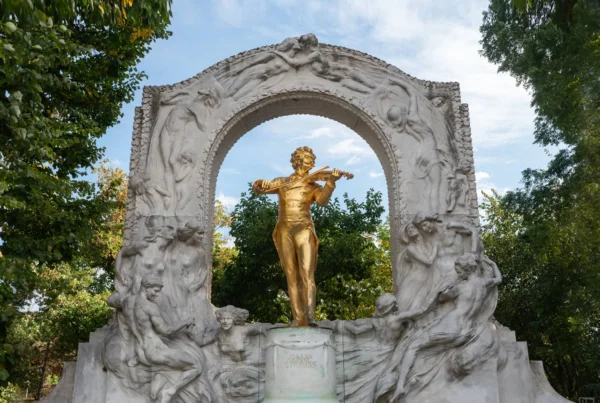Each year students, teachers and researchers travel from Austria to the US and vice versa on a Fulbright scholarship. The Fulbright Program, which has existed for over seven decades, bears the name of its creator, US Senator J. William Fulbright. Fulbright scholarships have given generations of scholars a unique opportunity to study and live in a foreign country thereby fostering mutual understanding and connections. Fulbright Austria was founded in 1950. The Executive Director of Fulbright Austria, Herman Agis, offers insights into the history, present and future of this unique educational exchange program.
Diana Mautner Markhof, 12 February 2024
German version
The Fulbright Program supports the exchange of students and scholars between the US and over 160 countries. Since its inception in 1946, over 380 000 students, teachers, and scholars have participated in the Fulbright Program; over 3800 Austrian citizens and 2800 US citizens are alumni of the Austrian-American program.
In 1946 Senator Fulbright proposed and sponsored this bill which was to use the proceeds from the sale of surplus war property outside the United States after World War II to finance exchanges of students, teachers, and professors. The Fulbright-Hays Act of 1961 which secured the funding for the Program. “Creative leadership and liberal education, which in fact go together, are the first requirements for a hopeful future for humankind. Fostering these—leadership, learning, and empathy between cultures—was and remains the purpose of the international scholarship program I was privileged to sponsor in the US Senate. “ (Senator J. William Fulbright)
 Dr. Herman Agis is an alumnus of the University of Natural Resources and Life Sciences (BOKU) in Vienna and the Medical University of Vienna (MedUni Wien). He was a visiting scholar at the Dental School of the University of Michigan. Agis received several awards and fellowships including the Rudolf Slavicek Award of the Austrian Society of Dentistry, the Erwin-Schrödinger Fellowship of the Austrian Science Fund, as well as the Robert Frank Award by the CED-IADR (Continental European Division of International Association for Dental, Oral, and Craniofacial Research). In 2019 he became Executive Director of the Austrian-American Educational Commission (Fulbright Austria).
Dr. Herman Agis is an alumnus of the University of Natural Resources and Life Sciences (BOKU) in Vienna and the Medical University of Vienna (MedUni Wien). He was a visiting scholar at the Dental School of the University of Michigan. Agis received several awards and fellowships including the Rudolf Slavicek Award of the Austrian Society of Dentistry, the Erwin-Schrödinger Fellowship of the Austrian Science Fund, as well as the Robert Frank Award by the CED-IADR (Continental European Division of International Association for Dental, Oral, and Craniofacial Research). In 2019 he became Executive Director of the Austrian-American Educational Commission (Fulbright Austria).
Picture: Herman Agis, Executive Director of Fulbright Austria © Mag. Barbara Lachner. Photosandmore.at 7684
iGlobenews: The creation of and support for the Fulbright Program reflects a shared vision for peaceful relations among nations. This statement taken from the Fulbright US website is a testament to Senator J. Fulbright, who introduced the legislation for this program in 1946. The aim was to foster the mutual understanding and appreciation of other cultures. Fulbright Austria was founded in 1950. What are the goals of the present Fulbright Austria program? Have the aims for Fulbright Austria changed since when the program was introduced?
Dr. Agis: The goals of Fulbright Austria align with the broader Fulbright mission of promoting mutual understanding and appreciation of diverse cultures. For more than seven decades, Fulbright Austria has aimed to facilitate academic and cultural exchange between the United States and Austria, fostering collaboration and building lasting connections. While the core mission remains consistent, Fulbright Austria has adapted to contemporary challenges by emphasizing cross-disciplinary collaboration, innovation, and addressing current global issues. Early on, Fulbright Austria embraced an entrepreneurial approach, helping the program grow, diversify, and increase its resilience. These strengths are all the more important in times when we are dealing with post-pandemic challenges, climate change, and a war in Europe. In these times, we heavily rely on the program’s core values: leadership, learning, and empathy between cultures.
iGlobenews: Austria is one of 160 countries where US Fulbright grantees can be sent. What areas of study do these US Fulbright students usually study? What is the ratio of men to women? How many students, on average study in the STEM areas? Do these students have to speak the language of the country they are sent to?
Dr. Agis: US Fulbright students in Austria pursue a variety of academic disciplines, spanning social sciences, humanities, sciences, and the arts. In addition to the typical research student grants, we also offer combined grants that allow students to pursue a research project, a community-based internship or service project while working as an English teaching assistant. The interests and expertise of the applicants drive the selection of areas of study. Fulbright Austria is committed to gender equality, diversity, and inclusion. The ratio of men to women among grantees varies each year. The number of students studying in STEM areas depends on the preferences and qualifications of the applicants. Together with our partner, the Austrian Marshall Plan Foundation, we offer five Fulbright-Austrian Marshall Plan Foundation Awards for Research in Science and Technology each year specifically dedicated to research in the STEM fields. Between 2013 and 2019, Fulbright supported around 143 mobilities to Austria for US students: 86 women and 57 men. In terms of thematic fields, these are predominantly divided into the humanities (87), the social sciences (22), and natural sciences (18).
The German language level we expect depends on the specific grant. While an intermediate level of German is required for the Fulbright-Mach Awards for Doctoral Candidates, it is recommended for the Fulbright-Austrian Marshall Plan Foundation Awards for Research in Science and Technology. We also support our students when they take German courses in Austria.
If you are interested in gaining a deeper understanding of Austrian-American relations, I highly recommend the study titled “Stocktaking of Cooperations and Networks between Austrian and North American Researchers, RTI Stakeholders and Institutions” (German: “Bestandsaufnahme der Kooperation und Vernetzung österreichischer und nordamerikanischer Forschender, FTI-Stakeholder und -Institutionen”).
iGlobenews: How many Austrians go to the US on Fulbright scholarships every year? What qualifications should applicants have?
Dr. Agis: The number of Austrians receiving Fulbright Student, Fulbright Scholar, and Fulbright Foreign Language Teaching Assistant grants to study, teach, and research in the United States varies annually. In total, we have 36 awards per year available for Austrian citizens. Applicants for Fulbright awards typically need to demonstrate academic excellence, leadership potential, and a commitment to cross-cultural engagement.
iGlobenews: Could you name some well-known Fulbright Austria alumni?
Dr. Agis: Each individual alum is a champion of our programs and a valued member of our community of bright minds. They serve as cultural ambassadors for both countries long after their program has ended. While providing an exhaustive list is challenging, some well-known Fulbright Austria alums include accomplished individuals in academia, government, business, and the arts. To give you an impression:
- Chuck Close (USA), painter
- Heinz Faßmann (Austria), former Federal Minister for Education, Science and Research of Austria and president of the Austrian Academy of Sciences since 2022
- Irmgard Griss (Austria), former president of the Supreme Court of Justice of Austria
- Paul Harather (Austria), director of “Indien”
- Wilhelm Holzbauer (Austria), architect
- Dr. Frances Mautner Markhof (Austria/USA), Executive Director Austrian Center for International Studies, Member of Fulbright Austria Alum Advisory Panel, former IAEA official, Executive Editor iGlobenews
- Stefan Sagmeister (Austria), graphic designer
- Friedrich St. Florian (Austria), designer of the US National World War II Memorial on the Mall in Washington DC
- Hannelore Veit (Austria), journalist
- Ruth Wodak (Austria), Distinguished Professor and Chair in Discourse Studies at Lancaster University; Stanford University
- Alma Zadić, Federal Minister of Justice of the Republic of Austria
- Anton Zeilinger (Austria), quantum physicist and Nobel laureate in physics of 2022
I also highly recommend the Remembering the Fulbright Experience collection on Audiovisuelles Archiv and the alum stories on our website and our YouTube channel.
iGlobenews: Fulbright grants can be given not only to students, but also for scholars, teaching assistants, professionals, and groups of researchers or projects. Are there Fulbright grantees in all these groups in Austria? If so, could you elaborate on this?
Dr. Agis: Indeed, Fulbright Austria’s programs in Austria are not limited to students; we offer opportunities for academics throughout their career. We offer programs for scholars, teaching assistants, researchers, professionals, and artists. This diversity reflects the program’s commitment to fostering collaboration across different sectors. Fulbright grantees engage in various activities such as studying, teaching, researching, and developing professionally, contributing to the cultural and academic vibrancy of Austria. In addition to managing the prestigious Fulbright program, Fulbright Austria administers the US Teaching Assistantship Program on behalf of the Austrian Federal Ministry of Education, Science and Research (BMBWF), which places over 150 US citizens in secondary schools throughout Austria to share their language and culture.
iGlobenews: As the Executive Director of Fulbright Austria, do you feel that the average Austrian knows what the programs are and what they have contributed to Austria and to the Austria-US relationships?
Dr. Agis: While Fulbright Austria has significantly contributed to Austria and US-Austria relations, public awareness may vary. Continuous efforts are made to enhance visibility through outreach, partnerships with educational institutions, and media engagement. The Fulbright Austria team is dedicated to increasing awareness of our programs’ impact on individuals, institutions, and the broader community, emphasizing their role in fostering global understanding and cooperation.
Ongoing communication and outreach initiatives are essential to ensure that the average Austrian understands the Fulbright Austria programs and their value to Austria and its relationships with the US. We actively promote our programs at educational fairs, symposia, and school and university events such as BeSt³ (Beruf Studium Weiterbildung, transl. Job, Studies and Continuing Education), NAFSA Annual Conference & Expo (Association of International Educators), the YSA-PhD Symposium (Young Scientist Association), and more. Additionally, we collaborate closely with the US embassy in Austria. Fulbright Austria also serves as an EducationUSA advising center in Austria, offering free advising services to students—via phone, email, or in person—tailored to each student’s unique academic situation.
Finally, I’d like to express my gratitude, Diana [Diana Mautner Markhof, Editor-in-chief, www.iglobenews.org], for allowing me to share the opportunities we offer with a broader audience on your platform. A warm thank you to all our alums who share the meaningful impact Fulbright Austria’s programs have had on their personal and professional lives, as well as on Austria-US relations in general. Thank you, Fulbright Austria community.







